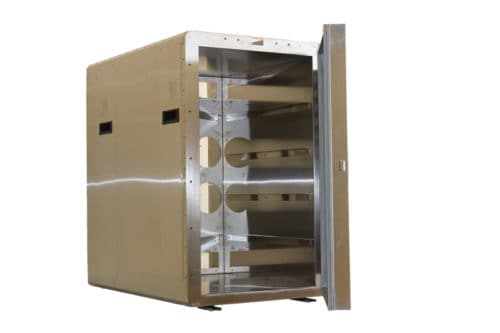T/J Fabricators is a leading provider of custom sheet metal fabrication services for customers around the world. Using state-of-the-art equipment, we form, bend, punch, and extrude even the most complex OEM components for an extensive range of applications. We pride ourselves on providing only the highest-quality sheet metal products through cutting-edge technology, skilled expertise, and premium materials.
What is Sheet Metal Fabrication?
Sheet metal fabrication is a category of manufacturing processes used to create products for numerous industries, including computers and electronics, food service, medical, military, banking, mass transit, banking, telecommunications, and many others. The actual processes involved may include any number of metalworking processes, including cutting, bending, forming, and stamping. Sheet metal fabrication consists of hot and cold forming processes, and each unique process provides different benefits based on the material and intended product.
Sheet Metal Fabrication Processes
Sheet metal fabrication processes create a wide range of products, from ATMs and retail display kiosks to commercial hand sanitizer stations and medical equipment. To create complex products and components with a high degree of precision, sheet metal fabricators incorporate a wide range of processes, including:
Cutting
Cutting removes material from a sheet metal blank to create the desired shape. A wide range of tools can cut sheet metal, such as blades, mills, laser cutters, electrode sparks, and waterjets.
Determining the most appropriate cutting method depends on the strength and thickness of the metal, as well as the complexity of the component. Physical cutters such as saws and mills provide an ideal cutting solution for large workpieces and thick sheets. In contrast, laser cutting is better for smaller or more intricate components that require a higher degree of precision.
Forming
Forming usually fits into sheet metal manufacturing after cutting and before finishing to create more complex objects. Sheet metal forming shapes the metal sheet with compressive force using various sheet metal forming methods:
- Bending. Bending uses press brakes to fold and bend sheet metal into desired shapes. The process requires strict engineering in advance of operations to ensure the material’s integrity during the procedure — especially with highly complex bends. Every material is different, and it is vital to have a thorough understanding of the material’s properties and limitations before attempting to bend it.
- Punching. Punching uses compressive force to create holes in the sheet in the desired pattern and shape. An operator places the sheet metal between a hollow shaped die and the punch, after which the punch presses against the sheet, deforming the metal and cutting a hole. The die forces its shape through the metal to create a punched hole, and the machine ejects the excess material.
- Extrusion. Sheet metal extrusion uses a similar process to punching because it uses a tool to punch a hole. Rather than removing the punched material entirely, the material gets extruded downward. This method is popular for fabricating self-tapping screws for storage systems, containers, and other enclosures.
- Embossing. Embossing also uses dies and compressive force to shape metal sheets. Instead of using a punch, fabricators use matching male and female dies to establish raised or recessed shapes and patterns in the metal without piercing the sheet. Embossing is frequently used to create patterns, textures, and writing on components for aesthetic purposes. It can also improve specific metal characteristics such as stiffness and traction or reduce static and friction.
Finishing
Metal cutting and forming processes often leave rough spots and sharp edges on the surface of the component. Finishing procedures use various tools to polish and clean edges and surfaces to create a smooth, flawless exterior. The parts may also be coated or painted to establish a barrier against moisture, UV rays, corrosion, heat, and other application-specific conditions.
Assembly
Assembly is the final step in the sheet metal fabrication process. Depending on the product, the assembly may include welding, riveting, bolting, or otherwise attaching or connecting components to create a final product.
Advantages of Sheet Metal in Fabrication
Sheet metal fabrication is highly versatile and offers numerous benefits over other manufacturing methods, including:
Wide Range of Applications
Sheet metal is quite versatile, making it an ideal material for creating a wide variety of designs and components. Using a combination of cutting, forming, and finishing methods, sheet metal fabricators produce durable and complex solutions for everything from automotive parts to medical equipment.
Flexible Run Size
Sheet metal fabrication handles volumes ranging from small scale prototyping and sample runs to large-volume, full-scale production runs. Fabrication facilities for sheet metal products typically have space and equipment to quickly and efficiently complete production runs of all sizes.
Materials to Suit Applications
Sheet metal encompasses an extensive range of materials, from mild steel and stainless steel to aluminum, brass, and copper. Sheet metal fabrication processes and finishes are modified to suit each material’s particular physical requirements and intended application.
Surface Finishes
Sheet metal fabrication includes multiple surface finish options to improve aesthetics and enhance the physical properties of the sheet metal. Common surface treatments include painting, powder coating, galvanizing, and electroplating, among others.
Materials Used in Sheet Metal Fabrication
Sheet metal features a thickness of no more than 6 mm and offers a variety of material options. Each material offers unique benefits and characteristics that make it useful for specific applications, including corrosion resistance, tensile strength, stiffness, strength-to-weight ratio, and finished appearance. Specific steel alloys and aluminum are the most common materials for sheet metal fabrication, but brass, magnesium, bronze, and copper are also used.
What Type of Steel Is Used for Sheet Metal?
Manufacturers value steel for its exceptional tensile strength, but only certain types of steel are compatible with sheet metal fabrication. Steels often used for sheet metal fabrication applications include:
Stainless Steel Sheet Metal Fabrication
Designers and fabricators favor stainless steel sheet metal for its strength and corrosion resistance. A minimum of 10.5% chromium content gives stainless steel a protective layer of chromium oxide, which keeps it from rusting when exposed to moisture and other corrosive elements. This property makes it particularly useful for medical equipment, food processing and distribution, kitchen equipment and appliances, and industrial storage tanks, valves, and pipes.
Hot-Rolled Steel Sheet Metal Fabrication
Hot-rolled steel forms easily at high temperatures and cools into robust and cost-effective parts. It is important to note that hot-rolled steel shrinks as it cools, which creates stress within the material and may cause a small degree of deformation or warping. As such, hot-rolled steel is best only for applications where exceptional accuracy is not a concern.
Cold-Rolled Steel Sheet Metal Fabrication
Cold-rolled steel first undergoes the same production processes as hot-rolled steel. Once the sheets cool to room temperature, they are subjected to additional compression at room temperature to improve the steel’s density and tensile strength. Cold-rolled steel is processed to thicknesses up to 3 mm and valued for its smooth, clean finish. Manufacturers rely on this material for fabricating outdoor steel constructions, consumer goods and appliances, metal furniture, school lockers, and cabinets.
Aluminum
Aluminum sheet metal is more expensive than its steel counterparts but offers a lightweight option with an exceptional strength-to-weight ratio. Although not as popular as steel due to its higher price tag, transportation and aerospace manufacturers often prefer it to create lightweight components. Aluminum sheet metal also sees frequent use in small consumer goods, such as laptop cases and cell phones.
Expert Sheet Metal Fabrication by T/J Fabricators
At T/J Fabricators, we pride ourselves on providing superior-quality sheet metal fabrication services for customers in any industry. Our advanced facility and extensive portfolio of fabrication services allow us to produce even the most complex OEM components with exceptional speed and efficiency. We offer fabrication services using a vast selection of sheet metal materials. We are always happy to work with you to ensure that you have the perfect material, process, and finish for your project.
To learn more about our custom sheet metal fabrication services, please contact our experts or request a quote today.







7 Comments
Maria
Good overview. Another interesting topic to cover is sheet metal bending: https://eziil.com/sheet-metal-bending
Aluminium Welding Auckland
Sheet metal fabrication is a versatile manufacturing process used in various industries to create precision products. T/J Fabricators excels in this field, utilizing cutting, bending, punching, and extrusion techniques to craft complex components from premium materials. From electronics to medical equipment, sheet metal fabrication plays a crucial role in developing products like ATMs, kiosks, and hand sanitizer stations. A careful selection of cutting methods, such as laser cutting for intricate designs, ensures the highest quality. Forming techniques like bending, punching, extrusion, and embossing further shape the metal. The process is completed by finishing, refining surfaces, and applying coatings for enhanced durability and aesthetics. I have also found this resource Gsme.co.nz useful and it related to what you are mentioning.
Mil-A-8625
The article gives a thorough introduction to sheet metal fabrication and walks readers through each step of the procedure. Mil-A-8625 Simplifying technical jargon could improve the content’s accessibility. Furthermore, practical examples could improve comprehension of the many sectors’ applications of sheet metal manufacturing.
For More Info:- https://anotekanodizing.com/
Davidson
Thanks for sharing such a great information.. It really helpful to me.. I always search to read the quality content and finally i found this in you post. keep it up!.https://www.duraslide.com.sg/our-products/stainless-steel
Chris Yao
how about the automated level of the sheet metal fabrication?
Chris Yao
how about the automated level of sheet metal fabrication?
Specially in loding materials part?
Jaiswal Udyog
This blog has great explanation on sheet metal fabrication. Also you can visit fabricator in Bhilai